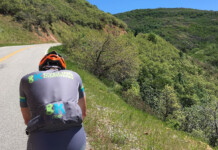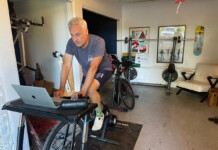The gamification of cycling is creating a whole new genre of cyclist who do most of their riding indoors, and love it! The days of the pain cave and suffer-fest may be over, with Zwift providing the convenience of virtual reality scenery, courses, and competition all in the safety of your spare room, basement or garage.
It’s not dissimilar to the rise of indoor rock-climbing gyms 20+ years ago. What was viewed initially as a backup option for bad weather days, a long drive to the crag, or a place to practice a few bold moves in preparation for “real climbing” instead spawned a whole new generation of “rock” climbers with excellent physical prowess but a dearth of skill for assessing and protecting their progress up natural lines on an actual cliff – unless those skills were also practiced and honed in the great outdoors.
So too with indoor cycling. Smart trainers, power meters, and nuanced training programs are helping cyclists work on developing their metabolic energy systems and power output – tuning up their motor for excellent performances. But if those performances are going to take place outside, a whole other skill set needs attention, and it’s called bike handling! “Yeah, but I know how to ride a bike”, you say. There’s a difference between being able to pedal a bike, and being able to ride a bike. Bike handling skills are what keep you upright and alive when riding outside, be it on you own or in a group, in competition or not. And they need attention and practice. Outside there are 4 primary hazard categories that you won’t encounter while sweating through your indoor cycling training program: corners, motorists, road surface hazards and other cyclists.
Let’s start with cornering. I distinctly remember my first ride on Zwift primarily for the fact that when I tried to lean the bike into corners on the course, it wouldn’t lean because it was stuck upright in a stationery trainer. The brain adapts, and the more you ride indoors looking at VR courses, the less your brain informs your body about the actual physics of steering a bike around a corner. It will need reminding and it better happen before you blow off the outside of a bend and into the rocks or down an embankment. Maybe you can use the thought of an emergency room bill as an incentive to practice cornering.
The #1 reason many people prefer to train indoors is for concerns about the #1 hazard riding outside, which is distracted drivers and the potential for being hit by one. Route selection and time of day go a long way toward minimizing this, but so too does paying keen attention to the sounds of approaching vehicles; looking at drivers to see where they are looking; and noting other “motor language”. Awareness and anticipation are critical skills for riding defensively. Riding in traffic requires sharp senses for survival, and although practice doesn’t guarantee safety, it contributes.
Motorists aren’t the only hazard. The road surface offers many including loose gravel, pot holes, broken edges, badly patched pavement, drainage grates, sticky or slippery new pavement, wet pavement, ice, disappearing shoulders, shredded truck tires, broken glass, dead animals, live animals, rockfall off an embankment, and DOT traffic hazard signs – which for some inexplicable reason are invariably set up in a bike lane. All of these things are manageable with bike handling skills. Look ahead, expect hazards, and be able to brake, steer nimbly around then, or unweight the front wheel or bunny hop over something. Some you will see coming and can easily avoid, and some will catch you by surprise and need an intuitive and immediate response if you are to maintain control. Riding outside exposes you to these hazards and helps you develop coping strategies.
The last hazard to skill up for is your fellow cyclist (or masses of them). For a truly terrifying experience, enter a charity ride or gran fondo that attracts a whole bunch of novice riders, start at the back and then try and ride up through the group. Riding in a group (of even 2 people) requires another whole layer of skill that you might think you are getting on a Zwift social ride inside, but you are probably not. Group riding requires a mix of anticipation, being predictable with your own actions, gear selection and shifting, smooth accelerations, brake feathering, pace lining and communicating via voice and hand signals. It’s enough to make someone want to stay at home on their indoor trainer!
But there are great reasons to get outside and ride. Most events, competitive or not, are still held outside. You can go places, see things, and encounter the unexpected. You might experience the wonder of sunrise or sunset (remember your lights, people!) and in recent times while outside riding I’ve enjoyed seeing gaggles of migrating geese, a badger, a black rabbit, a flock of whopping cranes and a train loaded with wind farm turbine blades. Sightings like these make rides memorable, as do positive encounters with other cyclists.
Triathletes – don’t think you are exempt from any of this! Even if you only ever do one closed course non-drafting event a year, getting time outdoors on your bike builds confidence on the bike. Confidence on the bike will reduce both your stress level and your calorie consumption. Speaking of which – you need practice keeping hydrated and fueled, which requires grabbing bottles and snacks while you are on the move, without having the stationery trainer hold your bike upright for you. You will ride faster and have more fun outside if you make a habit of working it into your training routine, and not just saving it for race day.
The continued development of smart trainers and online training platforms may well see further divergence of cycling into those who keep their riding indoors, and those who don’t. But if you are riding indoors primarily as preparation for an outdoor riding season or even just one event, it’s time to start moving some of your training time to the great outdoors.
Spring emerges. Keep your head up and enjoy new green leaves and blossoms while honing your bike handling skills. But while you are indoors, get a few actual “how to” bike handling tips from any number of videos on YouTube. Might as well make extra good use of that time inside!
John Higgins is a professional bike fitter and purveyor of unique and boutique bicycles and fit-related components and accessories in Salt Lake City. More info on bikefitr.com








